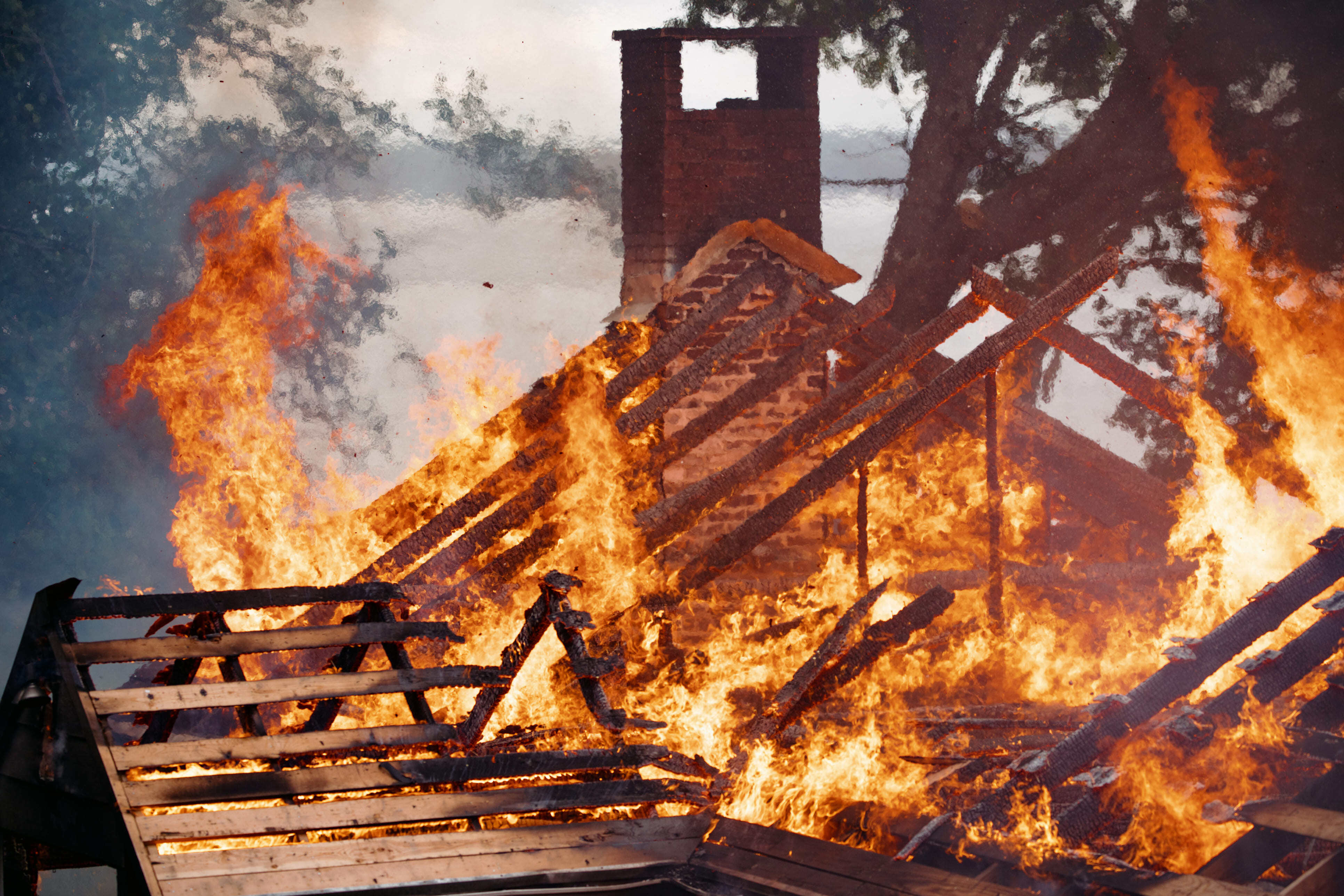Features > Property News & Insights > Housing Trends
Flood, fires and coastal erosion: Pricing the risks of Australian property

KEY POINTS
- A new series of reports highlights the vulnerability of millions of Australian homes to bushfires, floods, and coastal erosion
- The Domain research reveals a direct correlation between a property's susceptibility to natural disasters and its market value
- The findings raise concerns about the potential ramifications for insurance coverage in high-risk areas
If the recent flood event, which saw communities near Sydney evacuated and isolated for several days, wasn’t enough, three new publications from Australian Property Monitors’ Domain Group should sound alarm bells for Australians who own property at risk of natural hazards.
Domain’s first-ever “Perils Reports” attempt to quantify the downward pressure on property prices and the possible ramifications for insurance cover in areas at risk of bushfire, flood or coastal erosion.
They also help explain why insurance costs have soared for many Australians in potentially vulnerable areas.
The background
The Domain Group says increasingly severe weather patterns, influenced by climate change, “have amplified the occurrence of natural disasters,” placing more homes and communities at risk.
It says that while millions of homes around the country are at risk of natural disasters, “most homeowners and tenants are unaware, leaving them vulnerable and potentially uninsurable.”
Researchers have also found a direct relationship between the value of a home and its susceptibility to natural disasters.
Bushfires
5.6 million Australian homes—almost half of all properties—are at risk of bushfire.
According to Domain, this equates to property with a current estimated value of $4.66 trillion.
Not surprisingly, the most heavily populated states have the most properties at risk, led by New South Wales (1.9 million homes valued at $2 trillion), Queensland (1.6 million homes valued at $1.28 trillion) and Victoria (763,000 homes valued at $592.3 billion).
Domain allocates all properties in Australia a bushfire risk rating from 1-10, based on the “proximity and extent of surrounding vegetation, wind direction and distribution on days with high fire danger, the number of roads near the property (which provide a fire break) and the proportion of rainfall in the summer months.”
When all those factors are considered, only 0.3% of homes or 32,000 have a “5” or more rating.
It turns out that just under 50% or 15,082 of those properties are in just one state—Victoria—which also means it has the largest number of properties at high risk, with a value of $13.8 billion.
The Upper Yarra Valley and the Mount Dandenong-Olinda area (within the Yarra Ranges Shire) have very high bushfire risk ratings, at 7.70 and 5.39, respectively.
Mount Dandenong-Olinda (which is within the Greater Melbourne urban area) is also the area of Australia that has the highest number of properties (5,420) with a very high bushfire risk.
Domain’s research has found that over time, both buyers and vendors have priced risk into homes at risk of bushfire.
For each increase in its bushfire risk index number, Domain calculates this as a minus 2.0% effect on home prices.
Flooding
Domain’s researchers calculate that 953,000 Australian homes face a risk of flooding of 50 cm or greater—that’s 8.1% of all properties—with an estimated value of $768.5 billion.
Again, the most populous states have the vast majority, dominated by Queensland (344,453 homes valued at $282.9 billion), New South Wales (288,878 homes valued at $256 billion) and Victoria (197,342 homes valued at $147.1 billion).
They then considered what was “high-risk”, defining that as “where the chance of a flood is likely to happen in the lifespan of owning the property.”
Almost 141,000 properties fell into this category, with a total value of $99.1 billion.
New South Wales topped this high-risk list, followed by Queensland and the Northern Territory.
The Domain researchers say their analysis “reveals that buyers do consider flood risk in property pricing decisions, with higher flood risk leading to reduced property values.
They calculate this as follows:
- With each percentage point increase in the chance of a 50cm flood, the value decreases by 0.8%
- With each percentage point increase in the chance of a 1m flood, the value decreases by 1.1%
- With each percentage point increase in the chance of a 2m flood, the value decreases by 1.3%
Given the regularity with which floods occur and after examining insurance records, the researchers say New South Wales is projected to experience approximately $526 million in property damage from floods each year.
Queensland is not far behind, with an estimated $509.9 million in annual expected losses.
Victoria’s annual anticipated losses are significantly lower at only $162.5 million per year due to its much lower proportion of properties classed as “high risk”.
Coastal Erosion
Around 160,000 Australian homes are located within 150 metres of the coastline.
According to the Domain team, one in ten of these properties—worth a combined $26.41 billion—is at risk of coastal erosion.
When it comes to the state with the highest number of the properties at risk from coastal erosion, Queensland dominates with 7699, or 44% of the national total.
New South Wales follows with 4254 homes at risk and then South Australia with 2243.
Despite its large population, Victoria has just 241 properties at risk or 1.4% of the national total.
There are no surprises for guessing where Queensland’s coastal erosion hotspot is.
Just think of lots of expensive high-rise real estate located right on the beach.
The top four locations with the highest number of properties at greatest threat of coastal erosion in Australia are all on the Gold Coast, which has roughly $4.5 billion worth of homes at high risk.
However, here’s the really interesting finding.
The Domain team found that susceptibility to shoreline erosion “does not significantly impact property values, indicating that buyers may prioritise location and views over long-term erosion risks.”
An examination of a major coastal erosion event at Collaroy on Sydney’s Northern Beaches after a severe East Coast low that coincided with a king tide seems to back this up.
Nearly 50 metres of beach at Collaroy and nearby Narrabeen disappeared in the immediate aftermath of the storm, while foundations of properties were undermined, causing severe damage to a number of waterfront homes.
“The examination of the 2016 Collaroy coastal erosion incident suggests that while buyers may price in risk soon after an erosion event, there is a minimal overall effect on property prices over the long term,” the Domain Coastal Erosion Perils Report says.
However, the authors warn that “while buyers may not currently factor in shoreline erosion risk, it is crucial to recognise the potential long-term impacts.”
“Neglecting this risk could have consequences for property sustainability and resilience, emphasising the need for informed decision-making to safeguard investments.”
I’d suggest that’s extremely sound advice, particularly for property investors.
While many investors focus on price, rental yields, demographics and possible tax deductions when purchasing properties, they would be well advised to consider the findings of these reports as part of their due diligence.
“Buyers can make more informed decisions and safeguard their investments against possible damages and declining worth by incorporating the potential risks…into property valuation processes,” the authors say.
With many homeowners in flood and bush-fire prone areas of Australia complaining the costs of their insurance premiums have soared, perhaps part of that valuation process should also consider whether an investment property can be adequately insured at a reasonable price.
Stay Up to Date
with the Latest Australian Property News, Insights & Education.




.png?width=292&height=292&name=Copy%20Link%20(1).png)
 SIGN UP FOR FREE NEWSLETTER
SIGN UP FOR FREE NEWSLETTER








.jpg?width=1920&height=1080&name=Warning%2c%20You%20Might%20Be%20Facing%20Higher%20Taxes%20Soon%20(1).jpg)





.png?width=1920&height=1080&name=Rate%20Drops%20Signal%20BIGGEST%20Property%20Boom%20in%20DECADES%20(1).png)

.jpg?width=1920&height=1080&name=Labor%20vs%20Liberal%20These%20Housing%20Policies%20Could%20Change%20the%20Property%20Market%20Forever%20(1).jpg)
.jpg?width=1920&height=1080&name=QLD%20Slashes%20Stamp%20Duty%20Big%20News%20for%20Investors%20%26%20Home%20Buyers%20(1).jpg)
.jpg?width=1920&height=1080&name=Trump%20Just%20Slapped%20Tariffs%20%E2%80%93%20Here%E2%80%99s%20What%20It%20Means%20for%20Australia%20(1).jpg)
.jpg?width=1920&height=1080&name=Federal%20Budget%202025%20More%20Debt%2c%20No%20Housing%20%E2%80%93%20Here%E2%80%99s%20What%20You%20Need%20to%20Know%20(1).jpg)
.jpg?width=1920&height=1080&name=Australias%20Housing%20Crisis%20is%20about%20to%20get%20MUCH%20Worse%20(New%20Data%20Warns).jpg)
%20(1).jpg?width=1920&height=1080&name=Australias%20RENTAL%20CRISIS%20Hits%20ROCK%20BOTTOM!%20(2025%20Update)%20(1).jpg)
%20(1).png?width=1920&height=1080&name=Is%20Adelaide%20Still%20a%20Good%20Property%20Investment%20(2025%20UPDATE)%20(1).png)
.jpg?width=1920&height=1080&name=RBA%20Shocks%20with%20Rate%20Cuts!%20What%E2%80%99s%20Next%20for%20Property%20Investors%20(1).jpg)
%20(1).jpg?width=1920&height=1080&name=I%20Predict%20The%20Feb%20Rate%20Cut%20(My%20Price%20Growth%20Prediction)%20(1).jpg)
.png?width=1920&height=1080&name=Why%20Property%20Prices%20Will%20Rise%20in%202025%20Market%20Predictions%20(1).png)
.jpg?width=1920&height=1080&name=Why%20Investors%20Are%20Choosing%20Apartments%20Over%20Houses%202%20(1).jpg)
.jpg?width=1920&height=1080&name=Why%20Rate%20Cuts%20Will%20Trigger%20A%20Property%20Boom%20(1).jpg)
.jpg?width=1920&height=1080&name=Retire%20On%202Million%20With%20One%20Property%20(Using%20SMSF).jpg)
.jpg?width=1920&height=1080&name=4%20Reasons%20Why%20You%20Should%20Invest%20in%20Melbourne%20Now%20(1).jpg)
%20(1).jpg?width=1920&height=1080&name=Old%20Property%20vs%20New%20Property%20(Facts%20and%20Figures%20Revealed)%20(1).jpg)
%20(1).jpg?width=1920&height=1080&name=Will%20The%20New%20QLD%20Govt%20Create%20a%20Property%20Boom%20or%20Bust%20(My%20Prediction)%20(1).jpg)
%20Scott%20Kuru%20(1).jpg?width=1920&height=1080&name=Inflation%20Hits%20Three-Year%20Low%20(Will%20RBA%20Cut%20Rates%20Soon)%20Scott%20Kuru%20(1).jpg)
.jpg?width=1920&height=1080&name=How%20to%20Buy%20Investment%20Property%20Through%20SMSF_%20The%20Ultimate%20Guide%20(1).jpg)
.jpg?width=1920&height=1080&name=Victoria%20Slashes%20Stamp%20Duty%20Melbourne%20Set%20to%20Boom%20Scott%20Kuru%20(1).jpg)
.png?width=1571&height=861&name=Are%20Foreign%20Buyers%20Really%20Driving%20Up%20Australian%20Property%20Prices%20(1).png)
.jpg?width=1920&height=1080&name=The%20Single%20Factor%20That%20Predicts%20Property%20Growth%20Regions%20(1).jpg)
%20Scott%20Kuru%20(1).jpg?width=1920&height=1080&name=My%20Prediction%20On%20Rates%20%26%20Negative%20Gearing%20(Market%20Crash)%20Scott%20Kuru%20(1).jpg)

-1.png?width=1920&height=1080&name=Major%20Banks%20Cut%20Rates%20Will%20RBA%20Follow%20Suit%20(Sept%20Rate%20Update)-1.png)
%20Scott%20Kuru-1.png?width=1920&height=1080&name=Rate%20Cut%20Coming%20What%20New%20Zealands%20Move%20Means%20for%20Australia%20(Sept%20Prediction)%20Scott%20Kuru-1.png)
%20(1).jpg?width=1920&height=1080&name=Buy%20when%20the%20interest%20rates%20are%20high!%20(Why%20you%20must%20buy%20now!)%20(1).jpg)
.jpg?width=1920&height=1080&name=Carms_Revised%20Taxes%20Due%20Aug%209%20YT%20Thumbnail02%20(1).jpg)
.jpg?width=1920&height=1080&name=Carms_Too%20Little%20Too%20Late%20Aug%207%20YT%20Thumbnail01%20(1).jpg)









.jpg?width=1920&height=1080&name=Carms_Rate%20Drop%20In%20July%20Jun%2010%20YT%20Thumbnail02%20(1).jpg)
.jpg?width=1920&height=1080&name=Carms_Own%20a%20Property%20V6%20Jun%205_YT%20Thumbnail%20(1).jpg)









.png?width=1920&height=1080&name=Artboard%201%20(3).png)






.jpg?width=1920&height=1080&name=YT%20thumbnail%20%20(1).jpg)

